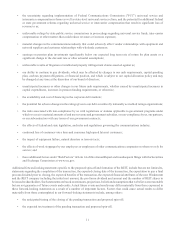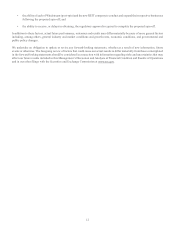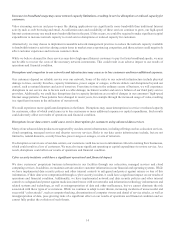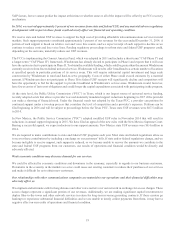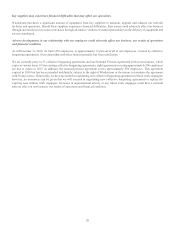Windstream 2014 Annual Report Download - page 90
Download and view the complete annual report
Please find page 90 of the 2014 Windstream annual report below. You can navigate through the pages in the report by either clicking on the pages listed below, or by using the keyword search tool below to find specific information within the annual report.14
Increases in broadband usage may cause network capacity limitations, resulting in service disruptions or reduced capacity for
customers.
Video streaming services and peer-to-peer file sharing applications use significantly more bandwidth than traditional Internet
activity such as web browsing and email. As utilization rates and availability of these services continue to grow, our high-speed
Internet customers may use much more bandwidth than in the past. If this occurs, we could be required to make significant capital
expenditures to increase network capacity to avoid service disruptions or reduced capacity for customers.
Alternatively, we may choose to implement reasonable network management practices to reduce the network capacity available
to bandwidth-intensive activities during certain times in market areas experiencing congestion, and these actions could negatively
affect customer experience and increase customer churn.
While we believe demand for these services may drive high-speed Internet customers to pay for faster broadband speeds, we may
not be able to recover the costs of the necessary network investments. This could result in an adverse impact to our results of
operations and financial condition.
Disruptions and congestion in our networks and infrastructure may cause us to lose customers and incur additional expenses.
Our customers depend on reliable service over our network. Some of the risks to our network infrastructure include physical
damage to lines, security breaches, capacity limitations, power surges or outages, software defects and disruptions beyond our
control, such as natural disasters and acts of terrorism. From time to time in the ordinary course of business, we will experience
disruptions in our service due to factors such as cable damage, inclement weather and service failures of our third party service
providers. Additionally, we could face disruptions due to capacity limitations as a result of changes in our customers’ high-speed
Internet usage patterns. These patterns have changed in recent years, for example through the increased usage of video, resulting
in a significant increase in the utilization of our network.
We could experience more significant disruptions in the future. Disruptions may cause interruptions in service or reduced capacity
for customers, either of which could cause us to lose customers or incur additional expenses or capital expenditures. Such results
could adversely affect our results of operations and financial condition.
Disruptions in our data centers could cause service interruptions for customers using advanced data services.
Many of our advanced data products are supported by our data center infrastructure, including offerings such as colocation services,
cloud computing, managed services and disaster recovery services. Risks to our data center infrastructure include, but are not
limited to, natural disasters, security breaches, power surges or outages, or acts of terrorism.
If a disruption occurs in one of our data centers, our customers could lose access to information critical to running their businesses,
which could result in a loss of customers. We may also incur significant operating or capital expenditures to restore service. As a
result, disruptions could affect our results of operations and financial condition.
Cyber security incidents could have a significant operational and financial impact.
We store customers’ proprietary business information in our facilities through our colocation, managed services and cloud
computing services. In addition, we maintain certain sensitive customer information in our financial and operating systems. While
we have implemented data security polices and other internal controls to safeguard and protect against misuse or loss of this
information, if their data were compromised through a cyber security incident, it could have a significant impact on our results of
operations and financial condition. Additionally, we have implemented network and data security policies and other internal
controls to safeguard and protect against malicious interference with our networks and information technology infrastructure and
related systems and technology, as well as misappropriation of data and other malfeasance, but we cannot eliminate the risk
associated with these types of occurrences. While we continue to adapt to new threats, increasing incidents of unsuccessful and
successful “cyber attacks”, such as computer hacking, dissemination of computer viruses and denial of service attacks, as well as
misappropriation of data, pose growing risks of a significant effect on our results of operations and financial condition and we
cannot fully predict the evolution of such threats.









